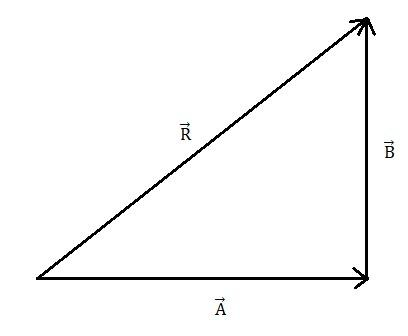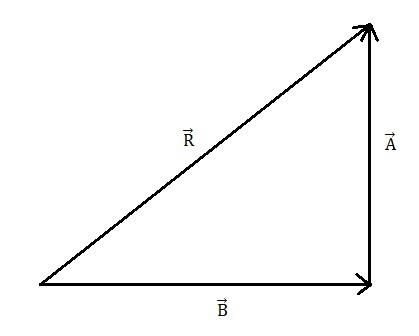
Assertion: Vector addition of two vectors A and B is commutative.
Reason:
\[\begin{array}{*{20}{c}}
{\overrightarrow A + \overrightarrow B }& = &{\overrightarrow B + \overrightarrow A }
\end{array}\]
A) Both assertion and reason are correct and the reason is the correct explanation for the assertion.
B) Both assertion and reason are correct but Reason is not the correct explanation for the assertion.
C) Assertion is correct but Reason is incorrect.
D) Both assertion and reason are incorrect.
Answer
139.8k+ views
Hint:
In this question, we have given that the vectors A and B are commutative and according to the commutative law, if two vectors are added in any order, then the resultant of those vectors will be the same. And we will determine the addition of two vectors that are to be added in any order. And then we will select the correct answer from the given options.
Complete step by step solution:
Let us assume that there are two vectors \[\overrightarrow A \]and \[\overrightarrow B \]. And \[\overrightarrow R \] is the resultant vector. therefore, we will add these two vectors using the triangle law of vector addition.
The Triangle law of vector addition says that if two vectors show the side of the triangle, then the third side of the triangle shows the resultant of the vector having the magnitude and the direction.
Now we will add the vector \[\overrightarrow A \] and \[\overrightarrow B \]. Therefore, we will get

Figure 1
From figure - 1, we can write
\[ \Rightarrow \begin{array}{*{20}{c}}
{\overrightarrow R }& = &{\overrightarrow A + \overrightarrow B }
\end{array}\]……….. (1)
And when we will add the vector \[\overrightarrow B \]and \[\overrightarrow A \], then we will get

Figure 2
From figure - 2, we will get
\[ \Rightarrow \begin{array}{*{20}{c}}
{\overrightarrow R }& = &{\overrightarrow B + \overrightarrow A }
\end{array}\] ……………… (2)
Now from the equation (1) and (2), we will get
\[ \Rightarrow \begin{array}{*{20}{c}}
{\overrightarrow A + \overrightarrow B }& = &{\overrightarrow B + \overrightarrow A }
\end{array}\]
Therefore, the assertion is correct and the reason is also correct. But the reason is not the correct clarification for the assertion.
Therefore, the correct option is B.
Note:
In this question, we have given that the vector addition of the two vectors is commutative. Therefore, it is important to note that if the addition of the vector is done in any order then, the resultant of the addition of two vectors is the same.
In this question, we have given that the vectors A and B are commutative and according to the commutative law, if two vectors are added in any order, then the resultant of those vectors will be the same. And we will determine the addition of two vectors that are to be added in any order. And then we will select the correct answer from the given options.
Complete step by step solution:
Let us assume that there are two vectors \[\overrightarrow A \]and \[\overrightarrow B \]. And \[\overrightarrow R \] is the resultant vector. therefore, we will add these two vectors using the triangle law of vector addition.
The Triangle law of vector addition says that if two vectors show the side of the triangle, then the third side of the triangle shows the resultant of the vector having the magnitude and the direction.
Now we will add the vector \[\overrightarrow A \] and \[\overrightarrow B \]. Therefore, we will get

Figure 1
From figure - 1, we can write
\[ \Rightarrow \begin{array}{*{20}{c}}
{\overrightarrow R }& = &{\overrightarrow A + \overrightarrow B }
\end{array}\]……….. (1)
And when we will add the vector \[\overrightarrow B \]and \[\overrightarrow A \], then we will get

Figure 2
From figure - 2, we will get
\[ \Rightarrow \begin{array}{*{20}{c}}
{\overrightarrow R }& = &{\overrightarrow B + \overrightarrow A }
\end{array}\] ……………… (2)
Now from the equation (1) and (2), we will get
\[ \Rightarrow \begin{array}{*{20}{c}}
{\overrightarrow A + \overrightarrow B }& = &{\overrightarrow B + \overrightarrow A }
\end{array}\]
Therefore, the assertion is correct and the reason is also correct. But the reason is not the correct clarification for the assertion.
Therefore, the correct option is B.
Note:
In this question, we have given that the vector addition of the two vectors is commutative. Therefore, it is important to note that if the addition of the vector is done in any order then, the resultant of the addition of two vectors is the same.
Recently Updated Pages
Average fee range for JEE coaching in India- Complete Details

Difference Between Rows and Columns: JEE Main 2024

Difference Between Length and Height: JEE Main 2024

Difference Between Natural and Whole Numbers: JEE Main 2024

Algebraic Formula

Difference Between Constants and Variables: JEE Main 2024

Trending doubts
JEE Main 2025 Session 2: Application Form (Out), Exam Dates (Released), Eligibility, & More

JEE Main 2025: Derivation of Equation of Trajectory in Physics

JEE Main Exam Marking Scheme: Detailed Breakdown of Marks and Negative Marking

Learn About Angle Of Deviation In Prism: JEE Main Physics 2025

Electric Field Due to Uniformly Charged Ring for JEE Main 2025 - Formula and Derivation

JEE Main 2025: Conversion of Galvanometer Into Ammeter And Voltmeter in Physics

Other Pages
Units and Measurements Class 11 Notes: CBSE Physics Chapter 1

JEE Advanced Marks vs Ranks 2025: Understanding Category-wise Qualifying Marks and Previous Year Cut-offs

NCERT Solutions for Class 11 Physics Chapter 1 Units and Measurements

Motion in a Straight Line Class 11 Notes: CBSE Physics Chapter 2

Important Questions for CBSE Class 11 Physics Chapter 1 - Units and Measurement

NCERT Solutions for Class 11 Physics Chapter 2 Motion In A Straight Line




